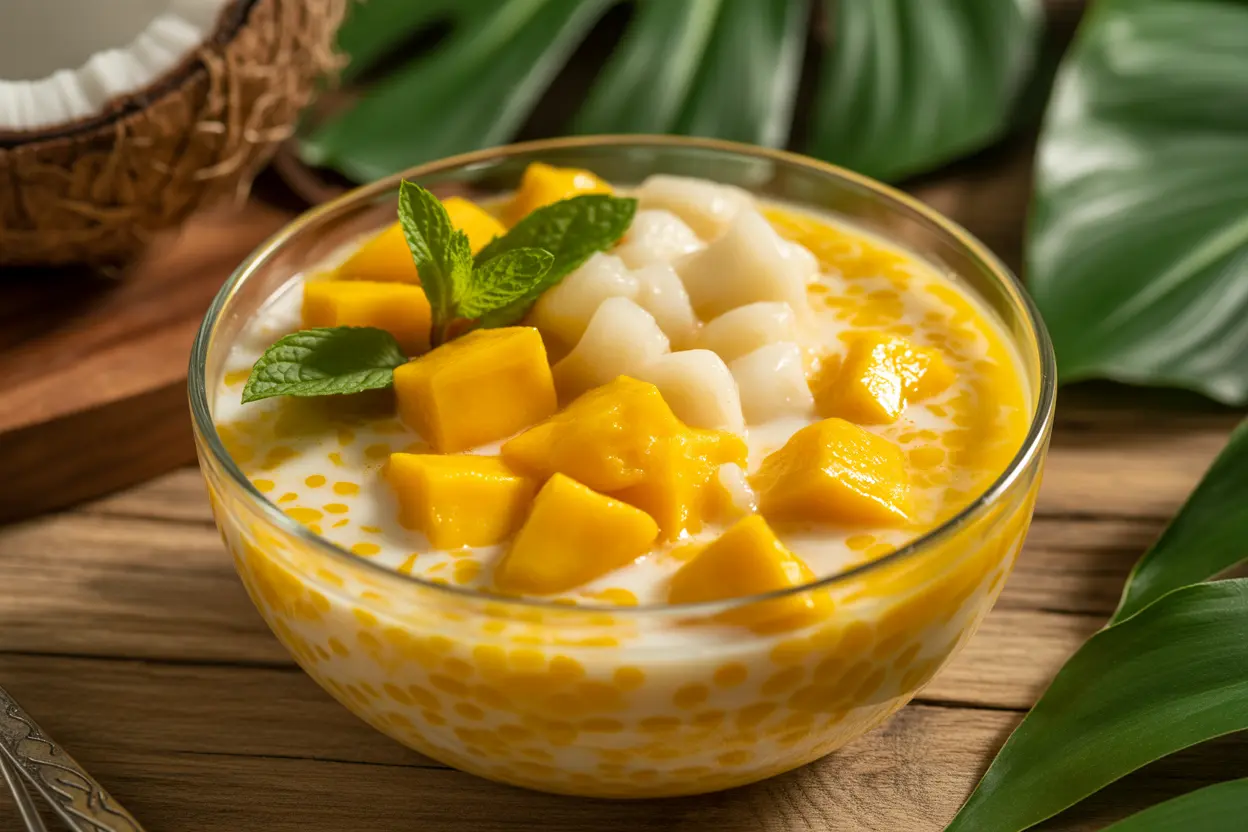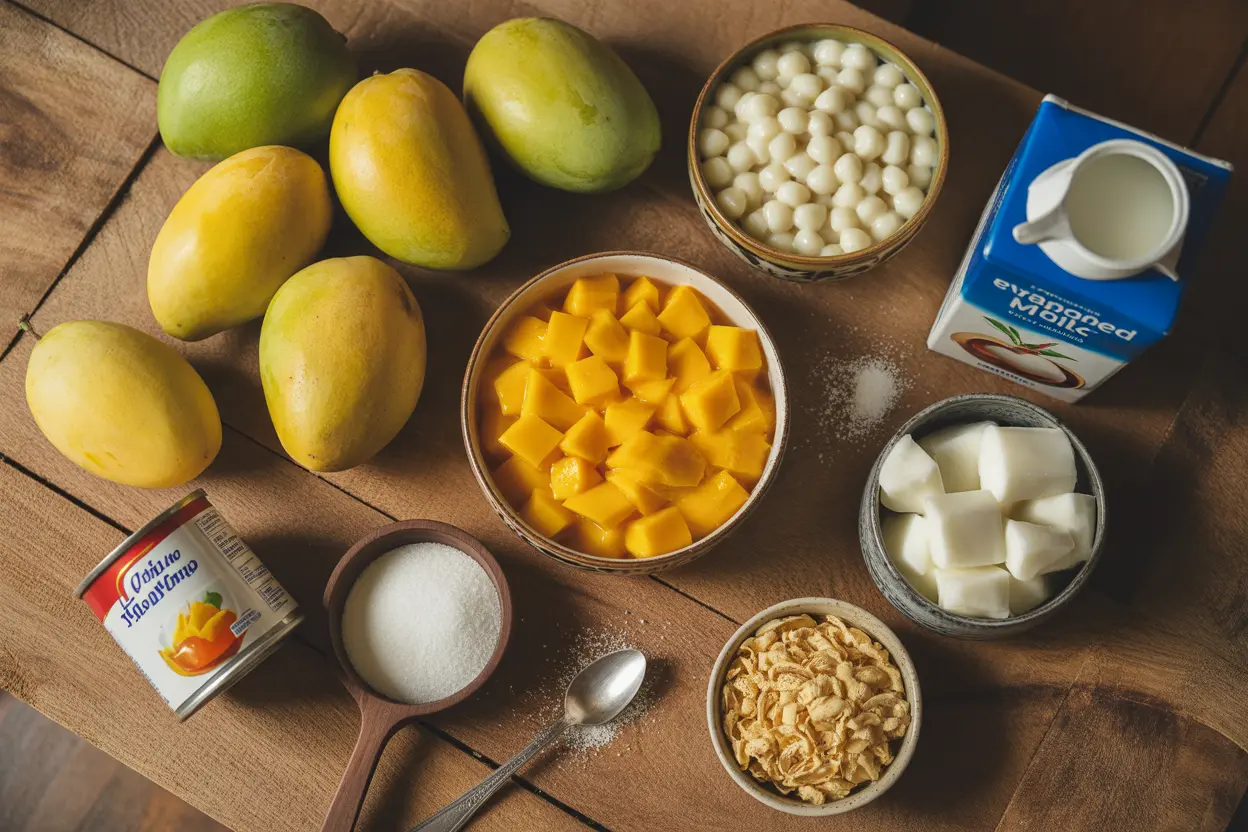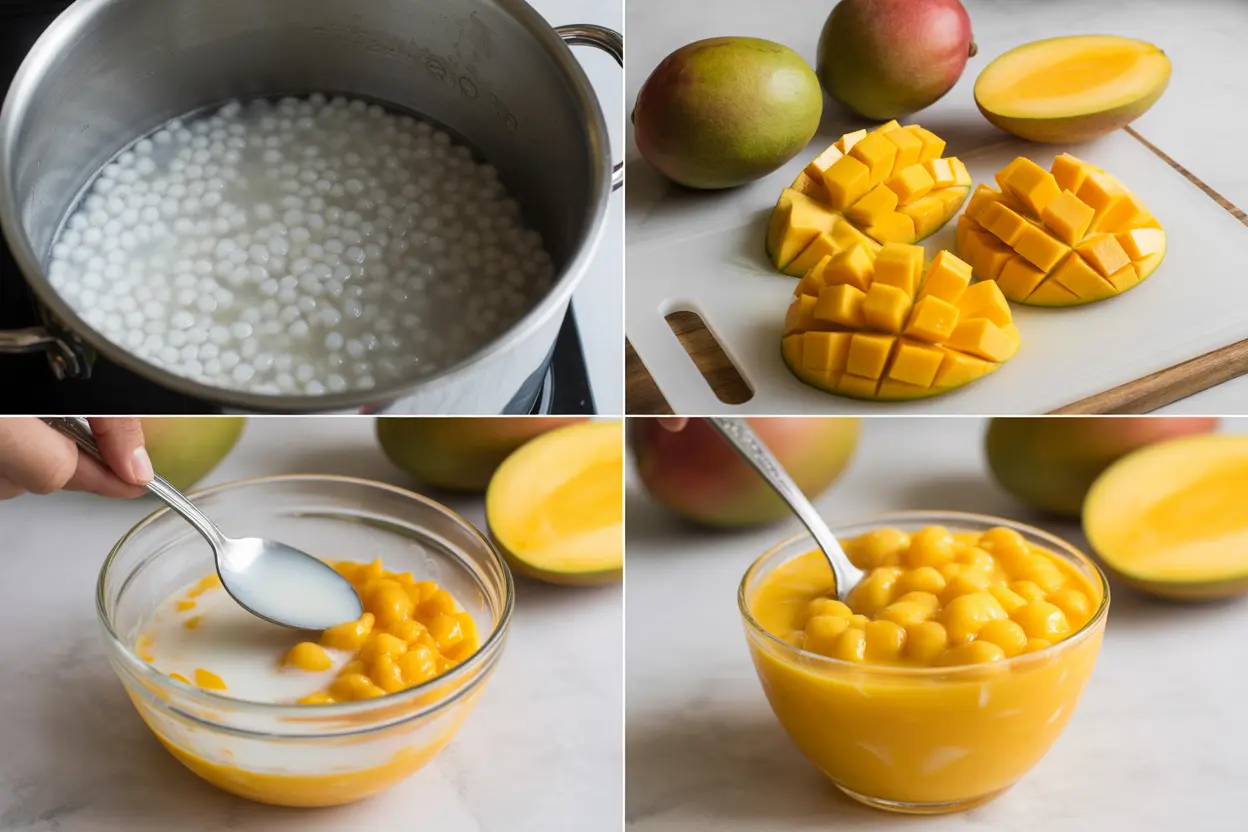What is Mango Sago?
Have you ever tasted the refreshing magic of mango sago? This chilled dessert is a delightful combination of sago or tapioca pearls and luscious mango cubes enveloped in a creamy milk base. Originating from Southeast Asia, mango sago is celebrated as a tropical fruit dessert that tantalizes your taste buds with its chewy texture mingling with juicy sweetness. If you’re curious about exploring this sweet treat further, check out this detailed tropical fruit dessert guide that beautifully captures the essence of mango sago.
Filipino Twist: Mango Bango
In the vibrant culinary world of the Philippines, mango sago takes on a unique identity known as Mango Bango. This version is a beloved staple in Filipino cuisine, blending the luscious qualities of Manila mangoes or Ataulfo mangoes with rich milk creams and tiny chewy pearls. It’s not just a dish but a tradition, and the perfect way to cool down on a humid day. Dive into the mango bango recipe details to grasp the heartwarming tradition of Filipino mango desserts and their sweet allure.

Key Ingredients
To craft authentic Filipino mango sago, you’ll want the freshest ingredients to guarantee that perfect harmony of flavors and textures. Here’s the secret sauce:
- Sago (tapioca pearls): These chewy pearls are the star texture of the dessert.
- Ripe Manila or Ataulfo mangoes: Juicy, sweet, with a buttery texture.
- Sweetened condensed milk: Adds sweetness and creaminess.
- Evaporated milk or all-purpose cream: Balances the richness.
- Sugar: To tweak the sweetness to your liking.
Using the freshest fresh mango varieties and quality dairy will bring out the best in your dessert. Not sure how to pick and prepare your mango for this treat? Explore using frozen mango in desserts for some convenient hacks!

Optional Add-ons and Variations
Want to jazz it up? Filipinos love adding different textures and flavors like:
- Nata de coco or coconut jelly: Adds a refreshing chew.
- Kaong (sugar palm fruit): For an extra tropical punch.
- Colorful gelatin cubes or rainbow jelly: Brightens presentation and adds playful textures.
Feel free to get creative! These variations make it your own special version of a classic Filipino dessert.
Preparing the Sago (Tapioca Pearls)
The foundation of a perfect filipino mango sago recipe lies in how well you cook the sago pearls. The goal? Achieving the ideal chewy tapioca texture that’s neither too hard nor mushy. Start by boiling a generous amount of water and slowly adding the sago. Stir occasionally until the pearls turn translucent, usually about 10-15 minutes. Rinse the cooked sago under cold water to stop the cooking process and prevent sticking. For an extra tip-packed guide, refer to this excellent how to cook tapioca pearls tutorial that dives deep into sago cooking guide and perfect sago texture tips.
Selecting and Preparing Mangoes
Choosing the right mango is crucial. Filipino mango sago shines brightest with sweet, fragrant Manila mangoes or their close cousin, the Ataulfo mango. Peel and dice the mangoes into bite-sized cubes to create bursts of tropical flavor in each spoonful. If fresh mangoes aren’t in season, don’t fret—there are smart alternatives! Explore the convenience of using frozen mango in desserts without sacrificing taste.

Mixing Ingredients: Mango, Sago, and Cream
Now, bring it all together. In a large mixing bowl, gently combine your chewy sago pearls with diced mango cubes. Pour in the sweetened condensed milk, evaporated milk, and all-purpose cream, adjusting amounts for your preferred creaminess and sweetness. This mixture should feel luscious and velvety, a perfect balance between fruity brightness and milky smoothness. Stir carefully so you don’t crush the mango cubes.
For some extra inspiration, the traditional mango sago recipe shares valuable mango sago preparation tips and Asian mango dessert instructions.
Chilling and Serving Tips
Here’s where magic happens—chill your mango sago in the refrigerator for at least an hour before serving. This step lets flavors meld and amplifies the dessert’s refreshing quality. Serve in a clear glass bowl to showcase those vibrant golden mango cubes and translucent pearls. Garnish with a few pieces of nata de coco or a sprig of mint for that Instagram-worthy touch.
When serving, be sure to keep it cold but not frozen. For guidance on storing mango sago right, check out this mango sago refrigeration guide.
Using Nata de Coco and Kaong
In the vibrant Filipino culinary scene, adding nata de coco and kaong elevates mango sago beyond just a dessert—it’s an experience. Nata de coco, made from fermented coconut water, provides a soft, chewy texture akin to coconut jelly. Meanwhile, kaong introduces a sweet crunch from sugar palm fruit. These additions accent the chewy tapioca and enrich the fruity cream base, offering an even more delightful and Filipino fruit dessert feel.
Incorporating these ingredients transforms your mango sago into a medley of textures and tropical tastes that truly celebrate local Filipino flavors.
Cream Options: Evaporated Milk, All-Purpose Cream, Coconut Milk
Creaminess is a cornerpiece of the filipino mango sago recipe. While evaporated milk and all-purpose cream are traditional favorites, coconut milk has carved its niche among cream lovers. Coconut milk brings a subtle nuttiness and aligns perfectly for those seeking a dairy-free or vegan-friendly spin.
Choosing between these depends on your palate: evaporated milk for that classic richness, all-purpose cream for extra smoothness, or coconut milk for a tropical nuance. Mixing and matching can lead to a unique and creamy dessert base that complements the mango’s sweetness wonderfully.
Texture and Ingredients Differences
Wondering how the filipino mango sago recipe stacks against its Hong Kong cousin? The differences are fascinating. Filipino mango sago typically uses larger, chewier sago pearls, with a creamier base incorporating condensed and evaporated milk or cream. In contrast, the Hong Kong-style mango sago often has smaller sago pearls and a lighter coconut milk-based sauce.
These ingredient variations influence the dessert’s mouthfeel significantly—Filipino mango sago tends to be richer and heartier, making it a comfort food dessert, while Hong Kong mango sago is lighter and more delicate.
Serving Styles and Sweetness Levels
Serving methods and sweetness levels reveal more contrasts too. Filipino mango sago is often chilled and served as a dense summer dessert, sweetened generously with sweetened condensed milk to suit Filipino taste buds, which generally prefer bolder sweetness. The Hong Kong version may be served chilled or cold but often with a subtler sweetness and sometimes includes additional fruit or jellies.
If you enjoy exploring key differences in bread types, you might appreciate how variations similarly impact these mango sago styles’ flavor and texture. For a broader view, the article on key differences in bread types offers insight on how small changes yield big culinary differences.
Choosing the Right Mango Variety
The star of any mango sago concoction is the mango itself. For authentic flavor and that signature buttery texture, opt for Manila mango or Ataulfo mango. These varieties are sweet, with minimal fibers, making every bite smooth and luscious. Avoid underripe or fibrous fruit, which can throw off the texture and sweetness.
Need tips on picking ripe fruits or alternatives? Look into using frozen mango in desserts, which offers year-round convenience without compromising on taste.
How to Cook Sago Perfectly
Sago pearls can be tricky; cooking them right is an art. Always boil in plenty of water, stirring frequently to prevent clumping. Cook until the pearls turn clear and slightly chewy but not gummy. Once done, immediately drain and rinse under cold water to halt cooking and maintain firm texture.
For a foolproof experience, check out this detailed sago cooking guide filled with pro tips on how to cook tapioca pearls and achieving that perfect sago texture.
How to Serve Mango Sago
Mango sago is best served chilled in transparent bowls or glasses, highlighting those vibrant mango cubes and glistening pearls. Try topping with a sprinkle of nata de coco or a few mint leaves to add color and a fresh aroma.
Pairing mango sago with light, nutritious side dishes can round out your meal, especially if serving at gatherings or celebrations.
Storage Tips and Shelf Life
Proper storage is key to freshness. Store mango sago in airtight containers in the refrigerator and consume within 2-3 days for best flavor and texture. The sago pearls may harden if stored too long, and the mango can lose its freshness.
For deeper insights, refer to storage tips and shelf life to keep your dessert delicious and safe.
What type of mango is best for Filipino mango sago?
The best mangoes for Filipino mango sago are the Manila mango and Ataulfo mango. These varieties are prized for their vibrant sweetness, buttery texture, and minimal fibers. Their naturally rich flavor blends beautifully with the creamy base and chewy sago, giving the dessert its signature taste.
How do you cook sago (tapioca pearls) properly?
To cook sago correctly, boil them in plenty of water while stirring frequently to prevent sticking. Cook until the pearls turn translucent and chewy—generally 10-15 minutes. After cooking, rinse with cold water to stop the cooking process and keep the pearls from clumping. Refer to comprehensive sago cooking guide for detailed tips.
Can I make mango sago vegan?
Absolutely! Substitute dairy components with coconut milk or other plant-based creams. Instead of sweetened condensed milk, use coconut condensed milk or maple syrup for sweetness. Ensure sago pearls are vegan-friendly, and you have a delicious vegan version of this tropical delight.
What is the difference between mango sago and mango bango?
Mango sago is a general Southeast Asian dessert with mango cubes and sago pearls in a creamy base. Mango bango is the Filipino adaptation, often richer with evaporated milk, sweetened condensed milk, and sometimes additional local additions like nata de coco and kaong. It’s a more indulgent and culturally rooted version of the dessert. Learn more about unique Filipino mango sweets in this deep dive.
How long can you store mango sago in the refrigerator?
For the freshest experience, store mango sago in an airtight container in the fridge and consume within 2-3 days. Beyond this, sago pearls may harden and mango may lose its juicy freshness. Follow this helpful mango sago refrigeration guide for optimal storage.
Conclusion
Filipino-style Mango Sago, also lovingly called Mango Bango, is a beloved chilled dessert that captures the heart of the Philippines with its creamy texture and sweet tropical flavors. The key to its success lies in choosing ripe Manila or Ataulfo mangoes, perfectly cooking sago for that ideal chew, and balancing creamy milk components with sweetened condensed milk. Optional Filipino staples like nata de coco and kaong bring authentic tropical twists.
Enjoy this dessert chilled, and make sure to savor it within a few days for peak freshness. Whether it’s an everyday treat or a special occasion, mango sago celebrates the rich fruit heritage of the Philippines and makes every spoonful a joyous delight.

1 thought on “Filipino Mango Sago Recipe: Authentic Tropical Dessert”